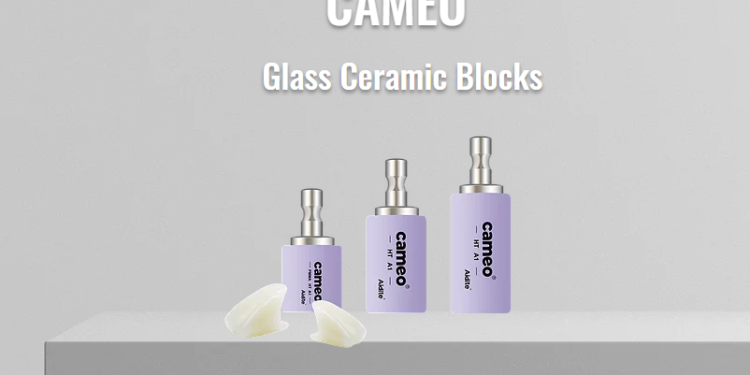When it comes to ultra-thin bionic veneer, is your impression still on the castable ceramic made in the factory? The truth is that with the application of CAD/CAM technology in dentistry, a different type of machinable ceramics has sprung.
In traditional processing of ultra-thin bionic veneer, the casting success rate of dental restoration will decrease dramatically if the thick of wax pattern under 0.5 millimeters. In contrast, the use of CAD/CAM technology for dental restoration materials has numerous advantages over traditional techniques in term of efficiency and quality.
Here comes the question: Which kind of machinable ceramics is more suitable for making ultra-thin veneer? And how is their edge stability? Next, we will show you through an experiment by four glass ceramics which are commonly used in clinic.

Table of Contents
From left to right:
◆ Aidite Cameo
◆ VITA Mark II
◆ Emax CAD
◆ Celtra
The test adopts the same dental restoration materials and processing method. Dentsply Sirona cerec support system is used to tests the dental restoration materials mentioned above. During the simulated test, the dental restoration materials is a 12 veneer and the thickness of restoration edge is less than 0.2mm.


Sagittal observation: the restoration adopts a blade-shaped edge design. (The design scheme of the restoration is only applicable to this experiment and it does not apply to any clinical patients.)


The restorations were placed under a microscope and observed with magnification of 5 times after processed.


From the perspective of marginal integrity, there is no doubt that Aidite Cameo is the best. The nanocrystalline structure not only provides better marginal stability and structural accuracy but also simulate the firmness of natural teeth.
CELTRA are also good in result with less gap. It can self-healing after sintering. The very essence of CELTRA is that it contains 10% zirconia material four times smaller than lithium silicate. Moreover, its content of high flexural strength and high glass matrix are up to 50%; the bending strength is even equivalent to enamel.
The IPS e.max also has a good result but there are some obvious defects in some parts.
As for the Mark II, the result comes out that it has a higher damage rate is marginal. Actually, the Mark II itself is also the weakest among the four materials.


The following is a comparison of some data after the test of four materials:
CELTRA — The dental restoration material is zirconium reinforced lithium disilicate glass ceramics. The elastic modulus is 70GPa. The initial flexural strength is 420Mpa and 370Mpa after sintering.
IPS e.max — The dental restoration material is lithium disilicate glass ceramics. The elastic modulus is 95Gpa. The initial flexural strength is 150Mpa and 360Mpa after sintering.
Aidite Cameo — The dental restoration material is lithium disilicate glass ceramics. The three-point bending strength is 400 ± 60Mpa.
Vita Mark II — The dental restoration material is Feldspathic porcelain. The elastic modulus is 63Gpa. The initial flexural strength is 150Mpa.


This set of tests demonstrate that reinforced glass-ceramics are more suitable for dental restoration materials with ultra-thin edges because it has high elastic modulus, good machinability and good edge continuity.
How to select the right restoration material?
For the selection of the dental restoration materials, mechanical characteristic, elastic modulus, flexural strength, stress distribution, tooth abrasion and indications should be considered. Aidite Cameo making the optimal combination of the above factors can be a good choice.
- Excellent mechanical strength. Three-point bending flexural up to 400±60Mpa allows CAD/CAM system to run the higher accuracy design. The difficulty of processing ultra-thin veneer restorations is reduced. It also improved the intensity and safety of the material in the mouth.
- Simulate the firmness of nature tooth. Compared with other types of material, the firmness of Aidite Cameo glass-ceramic is closer to the natural tooth of human. It can reduce the excessive wear of jaw teeth due to the difference of density and maintain the integration of abrasion between dental restoration materials and teeth.
- Overall adaptation with wearable feature. Scientific nanometer refinement, provide a marginal stability and structure accuracy to turning dental restoration materials. Aidite Cameo also effectively simplified the operational process of recurrent wear and polish. It brings the realization of the adaptive of technician process and clinical wear.


- Excellent diagnosis and treatment experiment of instant restore. As the ceramics materials whose contraction ratio is close to zero, Aidite Cameo will greatly facilitate the efficient design and digital machining. Upon this, Aidite Cameo combined the process of crystallization into porcelain to provide you with an ideal and comfort diagnosis treatment.
- Much more intuitive esthetic. Aidite Cameo possess with HT(High transmittance: A high light permeability, it restores the texture and color of the natural tooth. )and LT(Low transmittance: A optional low light permeability, it provide a healing effect of masking and complimentary ) two transmittance.
Thanks for taking the time to visit the website and learn more about the information. Hope this will contribute to the success of your overall dental health. Ready to get started? You can book an appointment to get fillings and dental implants in Syracuse ny.

